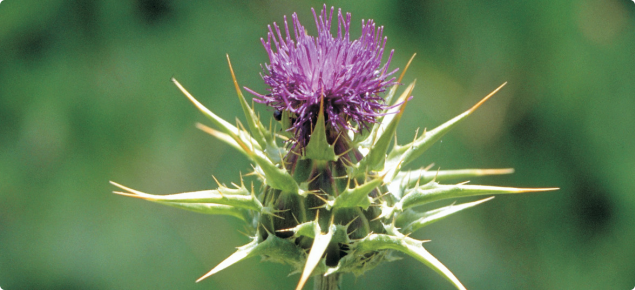Form: shrub — annual or biennial
Status: present in WA
Variegated thistle is native to southern Europe and the Mediterranean. It was probably introduced as a medicinal plant or a contaminant of grain before its weed potential in WA was recognised.
Appearance
Variegated thistle is usually an annual plant but occasionally does not flower until the second year. A large plant may cover an area of over one metre in diameter. It reproduces only from seed.
Leaves: Variegated thistle forms a broad rosette of shiny dark green leaves variegated by a network of white veins and patches. The leaves are deeply lobed with a long spine at the point of each lobe.
Flowers: In spring a branched flowering stem, without prickles, grows up to two metres high. Flowering starts in October and continues until early summer. One large purple flower head is produced at the end of each branch. Each head is enclosed by numerous overlapping bracts, each bract having a large stiff spine at the tip and shorter spines along the edge.
Seeds: The seeds are black or brown, about five millimitres long, somewhat flattened with a smooth seed coat. They are equipped with a parachute-like pappus of pale, barbed hairs about two centimetres long. Seed set takes place in summer. The seeds are too heavy to be blown far by wind in spite of the pappus, therefore most seeds fall onto the bare ground near the base of the parent plant. Variegated thistle seed may remain dormant in the soil for up to nine years. As little as 50% of the surviving seed may germinate in any one year.
Agricultural and economic impact
Pasture weed, toxic to stock.
In WA it has become an important weed of the high and medium rainfall districts of the south west of the State. When established it competes with more useful pasture plants for light, moisture and nutrients. Under certain conditions, variegated thistle is poisonous. It can kill cattle and, occasionally, sheep, especially when hungry animals consume large quantities in the absence of alternative feed. It becomes more palatable to stock - and more toxic - when it has wilted after cutting.
It has numerous spines which may cause injury to animals, including domestic dogs. Variegated thistle is also an important contaminant of wool and the plant provides excellent cover for rabbits.
Declared pest category
The Western Australian Organism List (WAOL) contains information on the area(s) in which this pest is declared and the control and keeping categories to which it has been assigned in Western Australia (WA). Search for variegated thistle in the WAOL using the scientific name Silybum marianum.
Requirements for land owners/occupiers and other persons
Requirements for land owners/occupiers and other persons if this pest is found can be sourced through the declared plant requirements link.
Search > detect > report
| MyPestGuide™ Reporter | Pest and Disease Information Service (PaDIS) |
Control method
Control methods for this declared plant can be found through the variegated thistle control and the variegated thistle: what you should know pages.
Further information
Further information on variegated thistle can be found on the variegated thistle: what you should know page.

